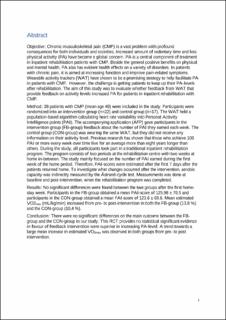| dc.description.abstract | Objective: Chronic musculoskeletal pain (CMP) is a vast problem with profound consequences for both individuals and societies. Increased amount of sedentary time and less physical activity (PA) have become e global concern. PA is a central component of treatment in inpatient rehabilitation patients with CMP. Beside the general positive benefits on physical and mental health, PA also has evident health effects on a variety of disorders. In patients with chronic pain, it is aimed at increasing function and improve pain-related symptoms. Wearable activity trackers (WAT) have shown to be a promising strategy to help facilitate PA in patients with CMP. However, the challenge is getting patients to keep up their PA-levels after rehabilitation. The aim of this study was to evaluate whether feedback from WAT that provide feedback on activity levels increased PA for patients in inpatient rehabilitation with CMP. Method: 39 patients with CMP (mean age 48) were included in the study. Participants were randomized into an intervention group (n=22) and control group (n=17). The WAT held a population-based algorithm calculating heart rate variability into Personal Activity Intelligence points (PAI). The accompanying application (APP) gave participants in the intervention group (FB-group) feedback about the number of PAI they earned each week. The control group (CON-group) was wearing the same WAT, but they did not receive any information on their activity level. Previous research has shown that those who achieve 100 PAI or more every week over time live for an average more than eight years longer than others. During the study, all participants took part in a traditional inpatient rehabilitation program. The program consists of two periods at the rehabilitation centre with two weeks at home in-between. The study mainly focused on the number of PAI earned during the first week of the home period. Therefore, PAI-scores were estimated after the first 7 days after the patients returned home. To investigate what changes occurred after the intervention, aerobic capacity was indirectly measured by the Åstrand-cycle test. Measurements was done at baseline and post-intervention, when the rehabilitation program was completed. Results: No significant differences were found between the two groups after the first home-stay week. Participants in the FB-group obtained a mean PAI-score of 125.98 ± 70.5 and participants in the CON-group obtained a mean PAI-score of 123.6 ± 69.6. Mean estimated VO2max (mL/kg/min) increased from pre- to post-intervention in both the FB-group (13,8 %) and the CON-group (10,4 %). Conclusion: There were no significant differences on the main outcome between the FB-group and the CON-group in our study. This RCT provides no statistical significant evidence in favour of feedback intervention were superior in increasing PA-level. A trend towards a large mean increase in estimated VO2max was observed in both groups from pre- to post intervention. | |
